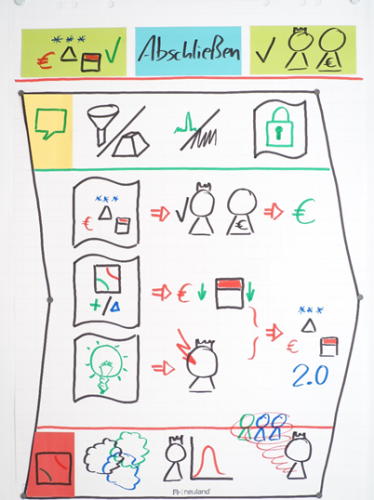Projektmanagement@GJW
DE
Abschließen
Warum: Projekt Ergebnis anerkennen lassen und für Zukunft lernen.
.
Wie: Abschließen.
.
Was: Ist das Projekt-Ziel erreicht (Input) folgt die Phase Abschließen.
Dabei spielt die nachvollziehbare Dokumentation eine große Rolle.
Basis ist ein gemeinsames Verständnis über das Erreichen des Projekt-Ziels mit dem Anwender/Kunden. Letztlich erfolgt nur dann die Bezahlung.
Als Projekt-Organisation besteht das Interesse für zukünftige Projekte Erkenntnisse über Erfolge, Verbesserungs-Potentiale und entdeckte Risiken zu berücksichtigen. Soll lässt sich die Produktivität in Projekten kontinuierlich steigern.
Beobachtungen weiterer Probleme und Ideen zu deren Lösung stellen die aktive Akquise-Basis für weitere Projekte dar.
In der Kommunikation sollten Erkenntnisse aus dem Präsentieren berücksichtigt werden (Wissenschaftlicher Trichter vs. Pyramidal; Signal-Rausch-Verhältnis …). Außerdem sollten alle Ergebnisse und Erkenntnisse für die lernende Projekt-Organisation nachvollziehbar und auffindbar gesichert werden.
Beim Risiko-Management sollte erneut der kognitiven Verzerrung vorgebeugt werden, das Rogers Innovationsdiffusionsmodell bewusst sein. Und vor allem sollte vermieden werden, dass das Projekt in den Strudel der operativen Arbeit beim Anwender/Kunden gerät und nicht abgeschlossen wird.
Der Output ist ein Anwender/Kunde, der sein Problem als gelöst ansieht und dementsprechend die Projekt-Rechnung bezahlt.
.
EN
Close
Why: Acknowledge project outcomes and learn for the future.
.
How: Close.
.
What: If the project goal is achieved (input), the Closure phase follows.
In this phase, comprehensible documentation plays a significant role.
The foundation is a shared understanding with the user/customer about achieving the project goal. Ultimately, payment occurs only when this is accomplished.
For the project organization, there is an interest in considering insights into successes, improvement potentials, and identified risks for future projects. This allows for the continuous improvement of productivity in projects.
Observations of additional problems and ideas for their solutions serve as the active acquisition basis for further projects.
In communication, insights from presentation techniques should be considered (Scientific Funnel vs. Pyramidal; Signal-to-Noise Ratio …). Additionally, all results and insights should be comprehensible and retrievable to ensure a learning project organization.
In risk management, cognitive biases should again be prevented, awareness of Rogers‘ Innovation Diffusion Model should be maintained. Above all, it should be avoided that the project gets entangled in the whirlpool of operational work at the user/customer end and remains unfinished.
The output is a user/customer who perceives their problem as solved and accordingly pays the project invoice.
Geplante/Erforderliche Verbesserungen
tbd
